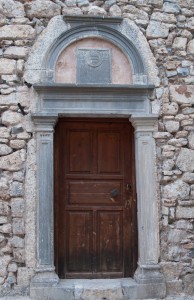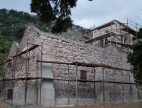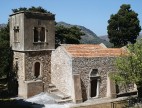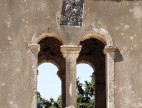Holy Monastery of Saint George the Vrachasotes
Even though the oldest reference to the monastery dates to 1549, during the abbotship of Joachim Kontoioannes, the dating of the wall-painted north aisle of the catholicon to the 14th century, places the first use of the space to an earlier period. Indeed, the heyday of the monastery, as can be determined from the surviving buildings, was the 16th century. In 1558, during the abbotship of Joachim, the impressive, western-style, tower-like belfry was built. The names of the donors, Joachim and Makarios, are listed on its south side, underneath the representation of St. George the Dragon-slayer in relief. In 1592 the south aisle, dedicated to St. Demetrios by the abbot Gedeon according to the surviving dedicatory inscription in iambic trimetre verse, was founded. After a period of abandonment, in the second half of the 19th century, the monk Anthimos Manioudakis reconstituted the monastery and rebuilt many of the ruined buildings around the catholicon. In the interior of the church, the elaborate wooden altar screen, crafted by the renowned wood-carvers from Lasithi, the brothers Markaki, has rich decoration in relief. Despite the fact that the monastery was inactive already from 1900, in the last years the surviving – mainly from the 19th century – buildings have been partially restored.






